The Spatiotemporal Relationship between Tourism Eco-Efficiency and Economic Resilience from Coupling Perspectives in China
Abstract
1. Introduction
2. Literature Review
2.1. Tourism Eco-Efficiency
2.2. Economic Resilience
2.3. Literature Comparison
3. Research Methods and Data Sources
3.1. Data Sources
3.2. Index Construction
3.2.1. Tourism Eco-Efficiency Index
3.2.2. Economic Resilience Index
3.3. Research Methods
3.3.1. Super-SBM Model with Undesirable Output
3.3.2. Entropy Weight Topsis Model
3.3.3. Coupling Coordination Model
3.3.4. Local Space Autocorrelation
4. Results
4.1. Tourism Eco-Efficiency Measures and Their Spatiotemporal Distributions
4.2. Economic Resilience Measures and Their Spatiotemporal Distributions
4.3. Coupling Coordination Analysis of Tourism Eco-Efficiency and Economic Resilience
4.3.1. Spatiotemporal Distributions of Tourism Eco-Efficiency and Economic Resilience Coupling Coordination
4.3.2. Spatial Correlation Distributions of Tourism Eco-Efficiency and Economic Resilience Coupling Coordination
5. Discussion
5.1. Theoretical Implications
5.2. Managerial Implications
5.3. Sustainability Recommendations
6. Conclusions
6.1. Findings
6.2. Limitations and Future Research
Author Contributions
Funding
Informed Consent Statement
Data Availability Statement
Conflicts of Interest
References
- Zhao, L.; Zhang, C. The threshold effect of tourism poverty reduction and its empirical test—A study based on inter-provincial panel data in western China. Financ. Trade Econ. 2018, 39, 130–145. [Google Scholar] [CrossRef]
- Sheng, Y.C.; Wu, X.Y. An Empirical Study on the Evolution and Effectiveness of China’s Tourism Industry Policy. Tour. Res. 2021, 13, 1–16. [Google Scholar]
- Pan, Z.Q.; Liang, B.E. A spatio-temporal heterogeneous study on the distribution of carbon emission intensity of tourism and its driving factors-analysis based on panel data of 30 provinces (cities and districts) from 2005–2014. Hum. Geogr. 2016, 31, 152–158. [Google Scholar] [CrossRef]
- Han, Y.; Goetz, S.J. The economic resilience of U.S. counties during the great recession. Rev. Reg. Stud. 2015, 45, 131–149. [Google Scholar] [CrossRef]
- Hong, Z.; Wang, L.; Zhang, C. Factors influencing the eco-efficiency of regional tourism in the context of green development—Taking the western region as an example. J. Ecol. 2021, 41, 3512–3524. [Google Scholar] [CrossRef]
- Tsionas, E.G.; Assaf, A.G. Short-run and long-run performance of international tourism: Evidence from Bayesian dynamic models. Tour. Manag. 2014, 42, 22–36. [Google Scholar] [CrossRef]
- Dc, A.; Jaf, B.; Acm, C. The impacts of the tourism sector on the eco-efficiency of the Latin American and Caribbean countries. Socio-Econ. Plan. Sci. 2021, 78, 101089. [Google Scholar] [CrossRef]
- Ye, T.L.; Li, G.L.; Liang, X.R. Can social capital effectively enhance regional economic resilience?—An empirical analysis from three major urban agglomerations in eastern China. Explor. Econ. Issues 2021, 5, 84–94. [Google Scholar]
- Sensier, M.; Bristow, G.; Healy, A. Measuring Regional Economic Resilience across Europe: Operationalizing a complex concept. Spat. Econ. Anal. 2016, 11, 128–151. [Google Scholar] [CrossRef]
- Li, B.J.; Song, Y.F. Rural “micro tourism” industry resilience enhancement path. Soc. Sci. 2023, 311, 57–63. [Google Scholar]
- Ma, X.F.; Tang, J.X. The impact of transportation accessibility on the resilience of tourism environment system and its spatial spillover effect in western Hunan. Geogr. Sci. 2023, 43, 291–300. [Google Scholar] [CrossRef]
- Zhang, C.; Zhang, Y.; Li, Y.; Li, S. Coupling Coordination between Fintech and Digital Villages: Mechanism, Spatiotemporal Evolution and Driving Factors—An Empirical Study Based on China. Sustainability 2023, 15, 8265. [Google Scholar] [CrossRef]
- Feng, K.; Li, W.; Nan, X.; Yang, G. Salt Cavern Thermal Damage Evolution Investigation Based on a Hybrid Continuum-Discrete Coupled Modeling. Sustainability 2023, 15, 8718. [Google Scholar] [CrossRef]
- Xi, J.P. Raising the Great Banner of Socialism with Chinese Characteristics to Unite the Struggle for the Comprehensive Construction of a Modern Socialist Country: Report at the 20th National Congress of the Communist Party of China; People’s Publishing House: Beijing, China, 2022. [Google Scholar]
- Chen, X.S. Research on economic management of green finance under the background of ecological civilization. Environ. Eng. 2021, 39, 258–259. [Google Scholar]
- Schaltegger, S.; Sturm, A. Kologische Rationalitt. Die Unternehm. 1990, 4, 273–290. [Google Scholar]
- Gössling, S.; Peeters, P.; Ceron, J.P.; Dubois, G.; Patterson, T.; Richardson, R.B. The eco-efficiency of tourism. Ecol. Econ. 2005, 54, 417–434. [Google Scholar] [CrossRef]
- Sariannidis, N.; Garefalakis, A.; Ballas, P.; Grigoriou, E. Eco-efficiency, sustainable development and environmental accounting in the tourism industry during a crisis. Corp. Board Role Duties Compos. 2018, 14, 58–64. [Google Scholar] [CrossRef]
- Cole, V.; Sinclair, A.J. Measuring the Ecological Footprint of a Himalayan Tourist Center. Mt. Res. Dev. 2002, 22, 132–141. [Google Scholar] [CrossRef]
- Wang, P.F.; Li, H.B. Research on the mechanism of regional economic resilience based on the perspective of industrial structure association—Jiangsu Province as an example. Adv. Geogr. Sci. 2022, 41, 224–238. [Google Scholar] [CrossRef]
- Liu, J.; Wen, D.; Tong, Y.; Ma, Y. Measurement and comparative study of eco-efficiency of regional tourism in China based on carbon emission accounting. J. Ecol. 2019, 39, 1979–1992. [Google Scholar] [CrossRef]
- Li, Z.L.; Wang, D.Y. Tourism economy in the Wuling Mountains area—Spatial and temporal divergence of eco-efficiency and influencing factors. Econ. Geogr. 2020, 40, 233–240. [Google Scholar] [CrossRef]
- Reggiani, A.; Graff, T.; Nijkamp, P. Resilience: An evolutionary approach to spatial economic systems. Netw. Spat. Econ. 2002, 2, 211–229. [Google Scholar] [CrossRef]
- Li, L.G.; Zhang, P.Y.; Tan, J.T.; Guan, H.M. The evolution of resilience concept and the progress of regional economic resilience research. Hum. Geogr. 2019, 34, 1–7. [Google Scholar] [CrossRef]
- Xu, Y.Y.; Wang, C. Influencing factors of regional economic resilience in the context of financial crisis—Taking Zhejiang Province and Jiangsu Province as examples. Adv. Geogr. Sci. 2017, 36, 986–994. [Google Scholar]
- Sun, J.W.; Sun, X.Y. Progress of regional economic resilience research and exploration of its application in China. Econ. Geogr. 2017, 37, 1–9. [Google Scholar] [CrossRef]
- Rizzi, P.; Graziano, P.; Dallara, A. A capacity approach to territorial resilience: The case of European regions. Ann. Reg. Sci. 2017, 60, 285–328. [Google Scholar] [CrossRef]
- Tan, J.; Zhang, P.; Lo, K.; Liu, S. Conceptualizing and measuring economic resilience of resource-based cities: Case study of Northeast China. Chin. Geogr. Sci. 2017, 27, 471–481. [Google Scholar] [CrossRef]
- Qi, X.; Zhang, J.S.; Xu, W.X. Research on the evaluation of county economic resilience development in Zhejiang Province. Zhejiang Soc. Sci. 2019, 5, 40–46. [Google Scholar] [CrossRef]
- Liu, Y.J.; Wang, S. The relationship between the coupling and coordination of retirement industry and tourism industry and economic growth in Yangtze River Economic Zone. Econ. Geogr. 2022, 42, 123–131. [Google Scholar] [CrossRef]
- Pendall, R.; Foster, K.A.; Cowell, M. Resilience and regions: Building understanding of the metaphor. Camb. J. Reg. Econ. Soc. 2009, 3, 71–84. [Google Scholar] [CrossRef]
- Ma, L.; Long, H.; Chen, K.; Tu, S.; Zhang, Y.; Liao, L. Green growth efficiency of Chinese cities and its spatio-temporal pattern. Resour. Conserv. Recycl. 2019, 146, 441–451. [Google Scholar] [CrossRef]
- Liao, B.; Li, L. How can urban agglomeration market integration promote urban green development: Evidence from China’s Yangtze River Economic Belt. Environ. Sci. Pollut. Res. 2022, 29, 10649–10664. [Google Scholar] [CrossRef]
- Cai, E.; Chen, W.; Wei, H.; Li, J.; Wang, H.; Guo, Y.; Feng, X. The coupling characteristics of population and residential land in rural areas of China and its implications for sustainable land use. Sustain. Dev. 2020, 28, 646–656. [Google Scholar] [CrossRef]
- Zhou, L.; Che, L.; Zhou, C.H. Spatial and temporal evolution characteristics and influencing factors of green development efficiency in Chinese cities. J. Geogr. 2019, 74, 2027–2044. [Google Scholar]
- Tong, Y.; Liu, H.M.; Ma, Y.; Liu, J.; Zhang, R. Impact of China’s tourism economy on urban green development and spatial spillover effects. J. Geogr. 2021, 76, 2504–2521. [Google Scholar] [CrossRef]
- Gao, L.T.; Meng, F.; Tian, Q.B. A study on the spatio-temporal evolution of China’s economic resilience and the factors influencing it—Based on digital finance perspective. Explor. Econ. Issues 2022, 8, 57–74. [Google Scholar]
- Xie, Q.Y.; Zhu, H.Y. Regional capital endowment differences in Zhejiang Province and their impact on economic resilience. Bus. Econ. Manag. 2022, 6, 68–80. [Google Scholar] [CrossRef]
- Gong, C.J.; Zhang, X.Q.; Xu, C.L. Study on the spatio-temporal evolution and synergistic enhancement of economic resilience of three major urban agglomerations in China. Soft Sci. 2022, 36, 38–46. [Google Scholar] [CrossRef]
- Wang, Z.; Li, T. A spatio-temporal coupling analysis of the dominance degree of inbound tourism flow collection and tourism economic efficiency in China. Hum. Geogr. 2021, 36, 157–166. [Google Scholar] [CrossRef]
- Duan, J.J.; Xuan, Z.Y. Analysis of the coupling relationship between county economic resilience and rural revitalization in Jiangsu Province in the context of Yangtze River Delta integration. J. Soochow Univ. Philos. Soc. Sci. Ed. 2021, 42, 32–43. [Google Scholar] [CrossRef]
- Wang, Z.F.; Wang, Z.Y. Study on the influence of environmental regulation on eco-efficiency of tourism industry and spatial differentiation in the middle reaches of Yangtze River urban agglomeration. J. Ecol. 2021, 41, 3917–3928. [Google Scholar] [CrossRef]
- Gan, C.; Wang, K. A study on the coupling and coordination of tourism development and economic resilience in Hunan Province. Geogr. Geogr. Inf. Sci. 2022, 38, 137–144. [Google Scholar]
- Zhang, M.D.; Feng, X.Q. A comparative study on the coordination of urban resilience and economic development levels of cities within the Yangtze River Delta city cluster. Urb. Dev. Res. 2019, 26, 82–91. [Google Scholar] [CrossRef]
- Yu, X.Q.; Ma, Y.R.; Yu, J. Research on the evaluation of the effect of coastal zone ecological restoration policy in Shandong Province based on entropy power TOPSIS model. Mar. Environ. Sci. 2022, 41, 74–79. [Google Scholar] [CrossRef]
- Liu, X.X.; Zhang, X.; Li, S.W. Measuring macroeconomic resilience in China—A systemic risk-based perspective. China Soc. Sci. 2021, 1, 12–32. [Google Scholar]
- Sun, Y.; Zhang, P.; Zhang, Y.F. Spatial pattern of coupling and coordinated development of innovation and entrepreneurship and the influencing factors. Explor. Econ. Issues 2022, 4, 37–54. [Google Scholar]
- Cao, K.J.; Wang, M.M. Spatial pattern evolution of beautiful rural areas in China and its influencing factors. Sci. Geogr. Sin. 2022, 42, 1446–1454. [Google Scholar] [CrossRef]

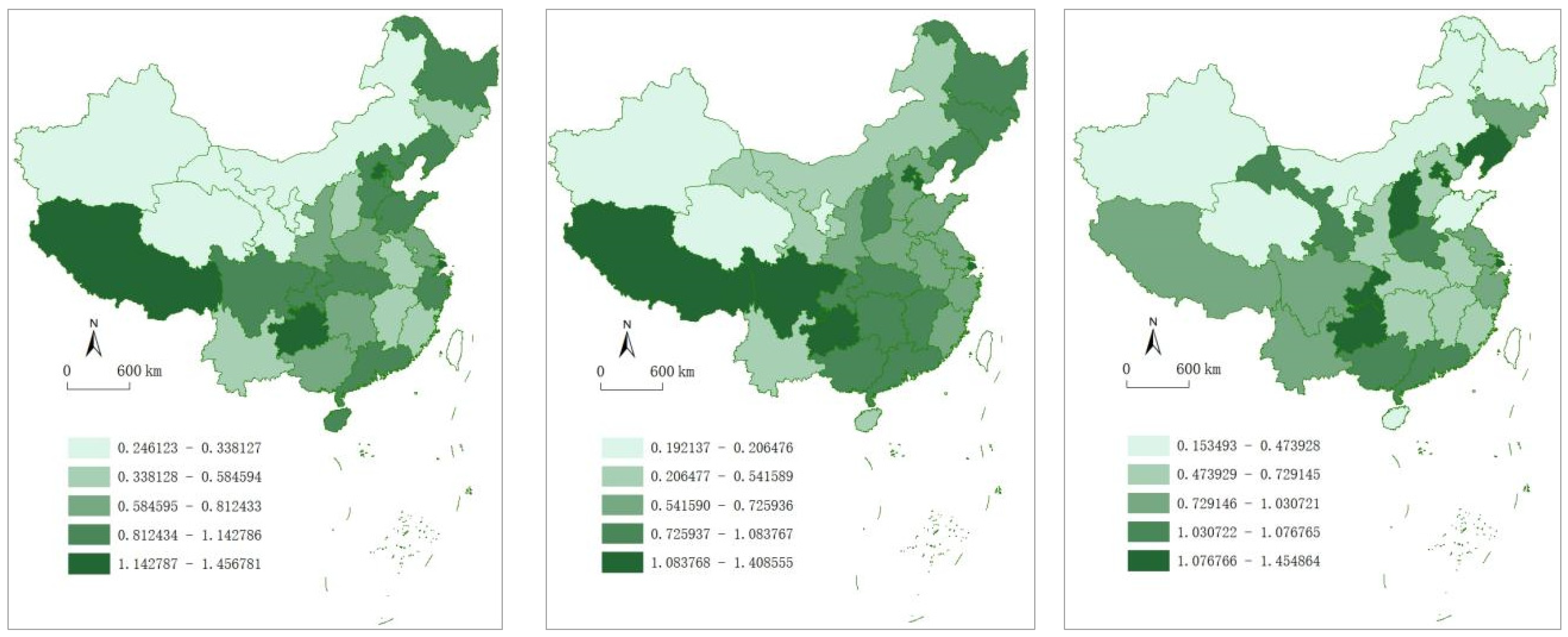

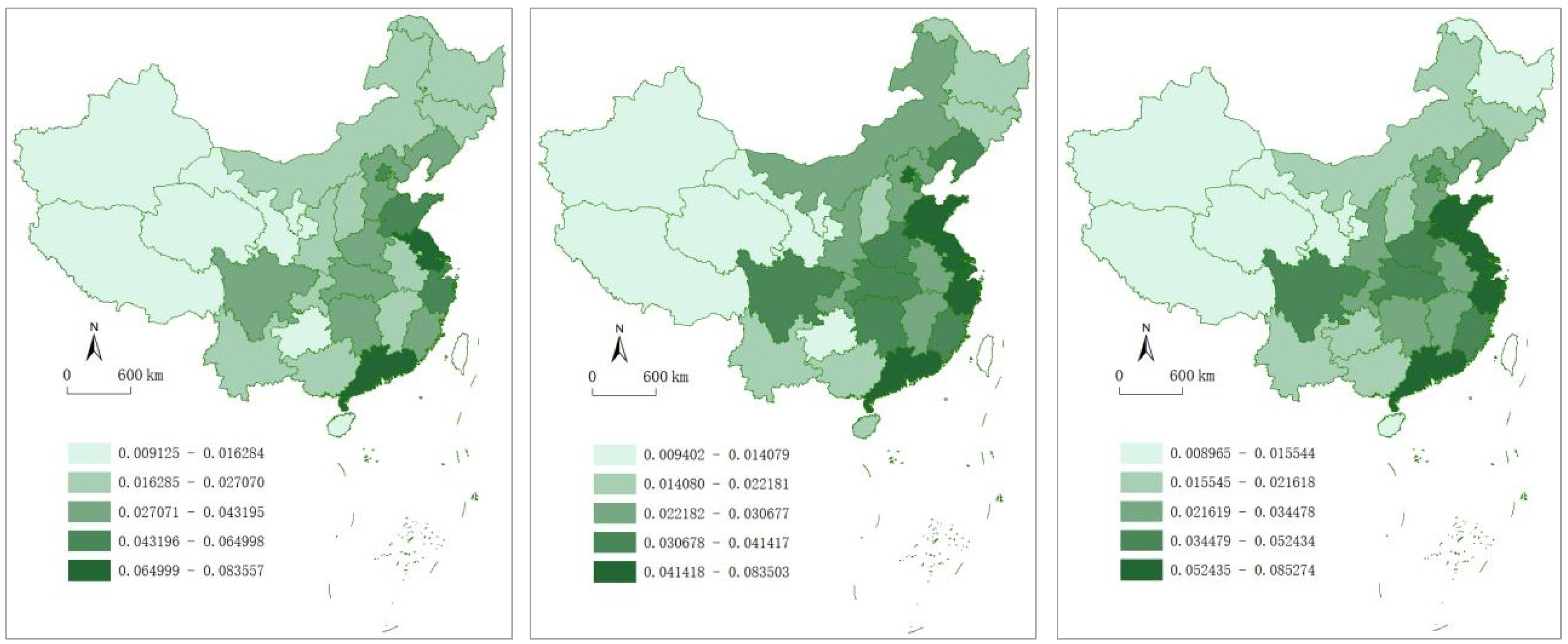
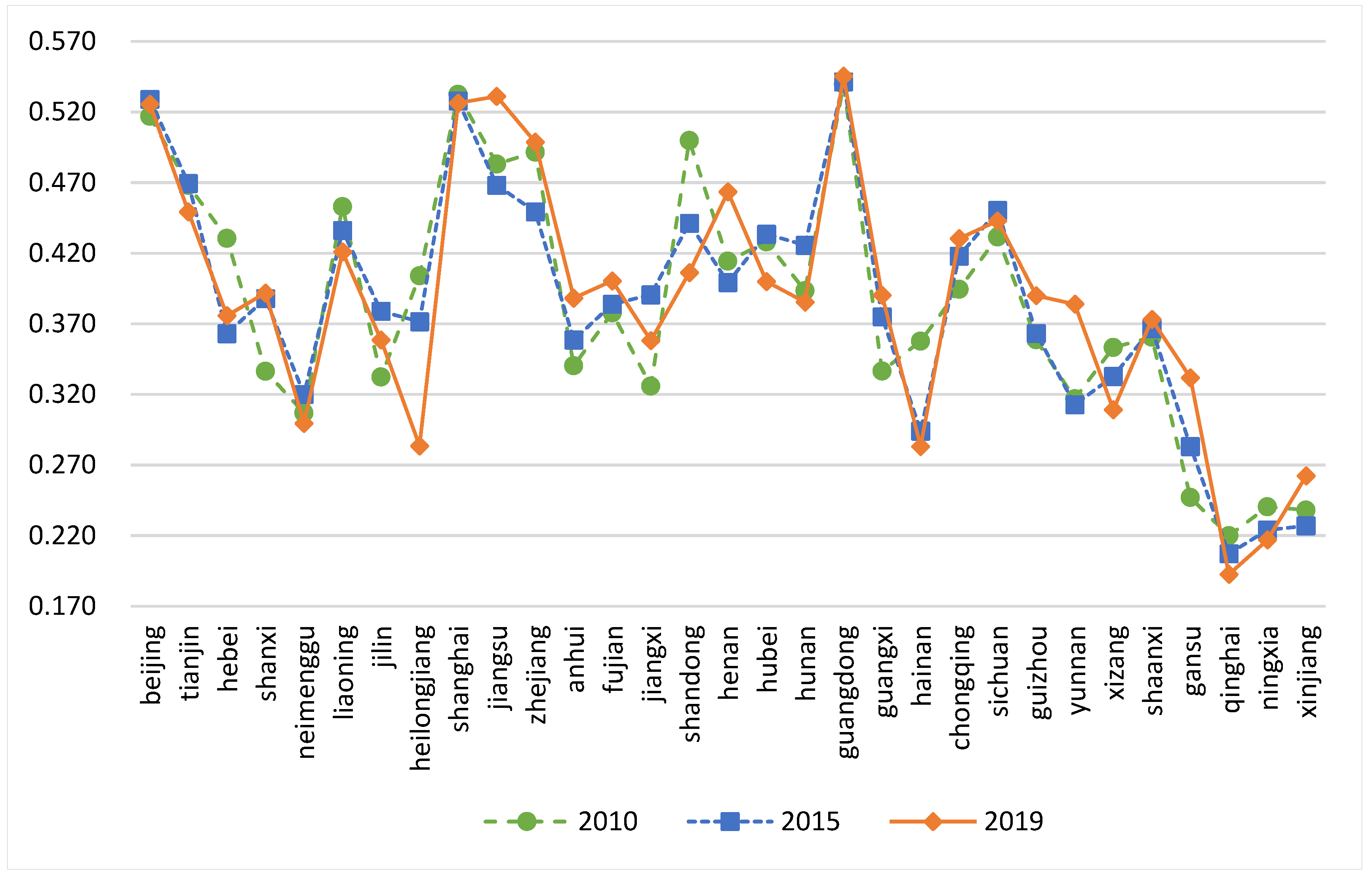
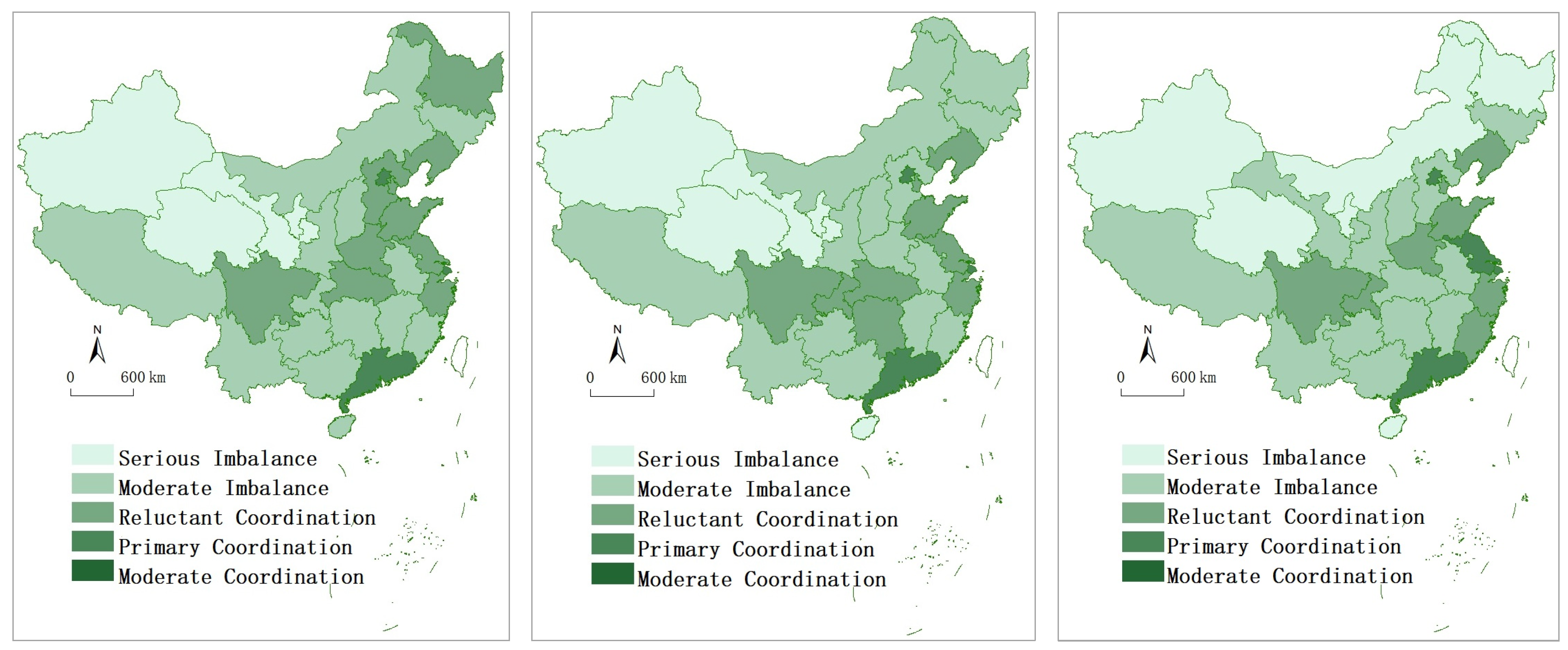
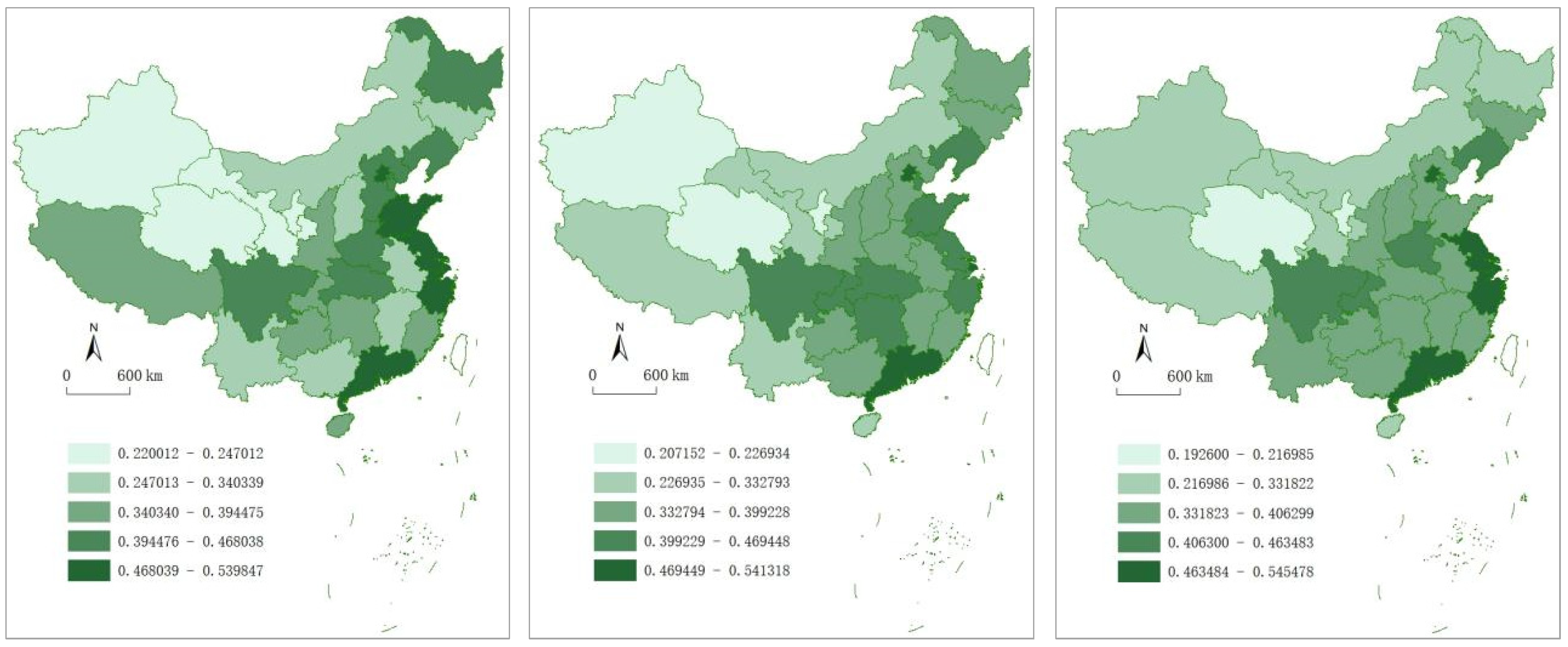
| Subsystem | First-Level Indices | Second-Level Indices |
|---|---|---|
| Tourism eco-efficiency | Input | The sum of star hotels, travel agencies, and weighted scenic spots (person) |
| Number of workers in the tertiary industry (person) | ||
| Investment in fixed assets for tourism (billion yuan) | ||
| Desired output | Total tourism revenue (billion yuan) | |
| Total number of visits (million people) | ||
| Undesired output | Tourism wastewater discharge (%) | |
| Sulfur dioxide emissions from tourism (%) | ||
| Economic resilience | Resistance and resilience | Per capita GDP (yuan/person) |
| Regional GDP (billion yuan) | ||
| Number of employed persons (million people) | ||
| Per capita disposable income (yuan/person) | ||
| Foreign trade dependency = total import and export/regional GDP (%) | ||
| Adaptability and adjustability | Local financial expenditures (billion yuan) | |
| Fixed asset investment (billion yuan) | ||
| Total retail sales of social consumer goods (billion yuan) | ||
| Financial self-sufficiency level = local revenue/local financial expenditures (%) | ||
| Number of participants in unemployment insurance at the end of the year (million people) | ||
| Innovation and transformation | Urbanization rate (%) | |
| Total post and telecommunications business (billion yuan) | ||
| Number of students enrolled in general colleges and universities (person) | ||
| Advanced industrialization = the proportion of primary production value × 1 + the proportion of secondary production value × 2 + the proportion of output value of three industries × 3 | ||
| R&D funding investment (million yuan) |
| Index | 2010 | 2015 | 2019 |
|---|---|---|---|
| Moran’s I | 0.225 | 0.154 | 0.169 |
| E (I) | −0.033 | −0.033 | −0.033 |
| Z (I) | 3.308 | 2.420 | 2.606 |
Disclaimer/Publisher’s Note: The statements, opinions and data contained in all publications are solely those of the individual author(s) and contributor(s) and not of MDPI and/or the editor(s). MDPI and/or the editor(s) disclaim responsibility for any injury to people or property resulting from any ideas, methods, instructions or products referred to in the content. |
© 2023 by the authors. Licensee MDPI, Basel, Switzerland. This article is an open access article distributed under the terms and conditions of the Creative Commons Attribution (CC BY) license (https://creativecommons.org/licenses/by/4.0/).
Share and Cite
Zhao, Y.; Wu, X. The Spatiotemporal Relationship between Tourism Eco-Efficiency and Economic Resilience from Coupling Perspectives in China. Sustainability 2023, 15, 10039. https://doi.org/10.3390/su151310039
Zhao Y, Wu X. The Spatiotemporal Relationship between Tourism Eco-Efficiency and Economic Resilience from Coupling Perspectives in China. Sustainability. 2023; 15(13):10039. https://doi.org/10.3390/su151310039
Chicago/Turabian StyleZhao, Yuan, and Xinyang Wu. 2023. "The Spatiotemporal Relationship between Tourism Eco-Efficiency and Economic Resilience from Coupling Perspectives in China" Sustainability 15, no. 13: 10039. https://doi.org/10.3390/su151310039
APA StyleZhao, Y., & Wu, X. (2023). The Spatiotemporal Relationship between Tourism Eco-Efficiency and Economic Resilience from Coupling Perspectives in China. Sustainability, 15(13), 10039. https://doi.org/10.3390/su151310039








